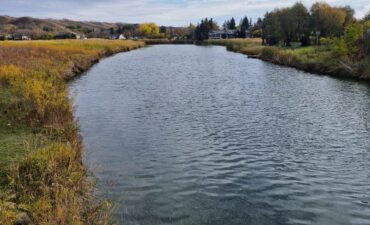The small dam northeast of Craven hides many secrets attached to famous Saskatchewan history.
The Craven Dam has been a staple of the Saskatchewan village for many years. Before the dam was built to regulate the water levels of the Qu’Appelle River, the location played a vital role for settlers and traders across the Qu’Appelle Valley.
Built following a significant flood in 1974, the dam has played a major role in keeping Craven and its surrounding area safe from flash floods, while controlling the water flow into major bodies of water such as Katepwa and Crooked lakes.
Although the current dam has been around for roughly 50 years, the river crossing has been a major part of the village’s life for over a century.
Craven Historian and Deputy Mayor Rick Taylor noted the historical significance of the crossing that began as a small bridge.
“In 1884 a bridge was built by the Binnie brothers, but that was the only bridge and the only crossing of the Qu’Appelle River system between Last Mountain Lake and Fort Qu’Appelle,” Taylor said.
The bridge played a key part for Craven and the surrounding towns as the crossing created an important point that eventually attracted the Hudson’s Bay Company.
In the late 1880’s, the company placed a trading post just north of Craven largely in part due to the proximity of the river crossing. These two important features helped develop the early town and attract settlers to the Qu’Appelle Valley.
The importance of the crossing was on full display in May of 1885 as the bridge was part of the route Canadian soldiers took on their way to Batoche, where they would eventually defeat Louis Riel and Gabriel Dumont’s Northwest Rebellion.
Since the original bridge was built, the crossing has remained an important gathering spot for the people of Craven.
Taylor can recall visiting the area in his youth and witnessing some of the spectacles the bridge provided.
“I remember going to that old wooden bridge in the mid 60″s with a friend of mine. On our way back to the city we decided to stop and fish there and it was shoulder to shoulder with people,” said Taylor.
Around 90 years after government troops marched over the bridge, reconfiguration and construction began to turn it into a dam.
Although there wasn’t a designated fishing deck built on the dam until 2002, locals would continue casting their lines in the river at the original dam construction site.
Since then, the dam has seen many renovations to increase its effectiveness and functionality while not disrupting wildlife.
Currently, the dam is undergoing changes to its operating systems as the government has invested in an electronic system that allows the Saskatchewan Water Security Agency to open the flood gates remotely. In the past, an operator would have to travel out to the structure to adjust the water levels.















